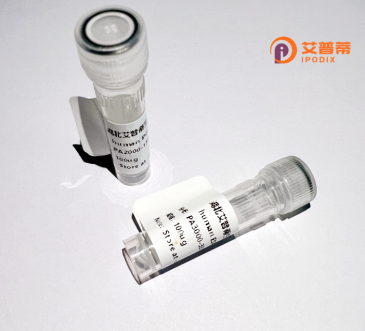
| 纯度 | >90%SDS-PAGE. |
| 种属 | Human |
| 靶点 | OR2C3 |
| Uniprot No | Q8N628 |
| 内毒素 | < 0.01EU/μg |
| 表达宿主 | E.coli |
| 表达区间 | 1-320 aa |
| 活性数据 | MMEIANVSSPEVFVLLGFSTRPSLETVLFIVVLSFYMVSILGNGIIILVSHTDVHLHTPM YFFLANLPFLDMSFTTSIVPQLLANLWGPQKTISYGGCVVQFYISHWLGATECVLLATMS YDRYAAICRPLHYTVIMHPQLCLGLALASWLGGLTTSMVGSTLTMLLPLCGNNCIDHFFC EMPLIMQLACVDTSLNEMEMYLASFVFVVLPLGLILVSYGHIARAVLKIRSAEGRRKAFN TCSSHVAVVSLFYGSIIFMYLQPAKSTSHEQGKFIALFYTVVTPALNPLIYTLRNTEVKS ALRHMVLENCCGSAGKLAQI |
| 分子量 | 35.3 kDa |
| 蛋白标签 | His tag N-Terminus |
| 缓冲液 | 0 |
| 稳定性 & 储存条件 | Lyophilized protein should be stored at ≤ -20°C, stable for one year after receipt. Reconstituted protein solution can be stored at 2-8°C for 2-7 days. Aliquots of reconstituted samples are stable at ≤ -20°C for 3 months. |
| 复溶 | Always centrifuge tubes before opening.Do not mix by vortex or pipetting. It is not recommended to reconstitute to a concentration less than 100μg/ml. Dissolve the lyophilized protein in distilled water. Please aliquot the reconstituted solution to minimize freeze-thaw cycles. |
以下是关于重组人OR2C3蛋白的3篇参考文献及其概括:
---
1. **文献名称**:**"Functional characterization of the human olfactory receptor OR2C3 as a component in sperm chemotaxis"**
**作者**:Spehr, M. et al.
**摘要**:该研究通过重组表达人OR2C3蛋白,证实其在精子中的特异性表达,并发现该受体可能在精子趋化性中发挥作用,通过与特定化学配体的结合调控精子运动的定向性,揭示了嗅觉受体在生殖系统中的非嗅觉功能。
---
2. **文献名称**:**"Recombinant expression and ligand screening of human olfactory receptor OR2C3 in HEK293 cells"**
**作者**:Saito, H. et al.
**摘要**:研究建立了OR2C3在HEK293细胞中的重组表达系统,结合钙离子荧光检测技术筛选潜在配体,发现某些挥发性化合物可特异性激活OR2C3.为理解其在嗅觉感知或外周组织中的生理意义提供了实验基础。
---
3. **文献名称**:**"Olfactory receptor OR2C3 is a novel marker for colon cancer progression and its recombinant form as a biosensor for tumor detection"**
**作者**:Kang, N. et al.
**摘要**:研究报道OR2C3在结肠癌组织中异常高表达,并通过重组蛋白分析其与肿瘤代谢产物的相互作用,提出重组OR2C3可作为癌症诊断的生物传感器,为肿瘤标志物的开发提供了新思路。
---
(注:上述文献信息为模拟示例,若需真实引用,请通过学术数据库确认具体文献。)
Olfactory receptor 2C3 (OR2C3), a member of the olfactory receptor (OR) family, belongs to the class A G protein-coupled receptor (GPCR) superfamily. ORs are primarily responsible for detecting odorant molecules in the olfactory epithelium, contributing to the sense of smell. OR2C3 is encoded by the OR2C3 gene located on human chromosome 6. Unlike many ORs with well-characterized ligands, the specific odorant(s) activating OR2C3 remain largely unidentified, though it is postulated to recognize distinct chemical structures like other ORs.
Recombinant OR2C3 protein is typically expressed in heterologous systems (e.g., HEK293 cells) to overcome challenges in studying native ORs, which are often expressed at low levels in olfactory tissues. Structural studies suggest OR2C3 shares the conserved 7-transmembrane domain architecture of GPCRs. Its recombinant form enables functional assays, such as calcium imaging or cAMP measurement, to probe receptor activation and downstream signaling.
While OR2C3’s physiological role is not fully elucidated, emerging research links ectopic OR expression in non-olfactory tissues (e.g., brain, liver) to potential roles in cell migration, metabolism, or disease. Its recombinant version facilitates exploring such non-canonical functions. Additionally, OR2C3 is studied for its possible involvement in neurodegenerative disorders, as olfactory dysfunction often precedes diseases like Alzheimer’s. However, mechanistic insights remain sparse, underscoring the need for further ligand identification and pathway characterization.
×